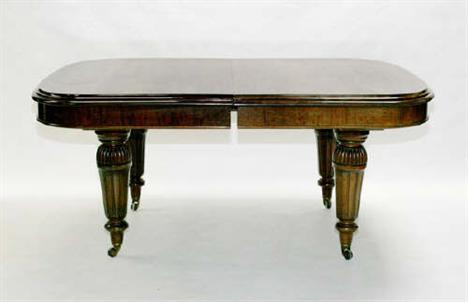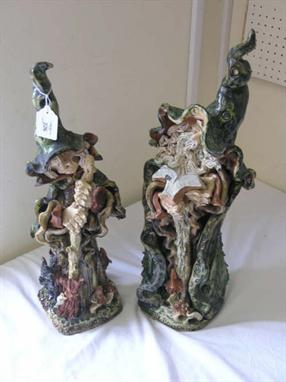A Victorian burr walnut rounded rectangular card table, the folding top rotating to reveal a baize playing surface above an arrangement of compartments, inlaid in boxwood with scrolling foliage and stringing, trestle base with turned end supports and stretcher, stiff leaf carved cabriole legs, white ceramic castors, 91cm wide, 77cm high, c. 1865
We found 163696 price guide item(s) matching your search
There are 163696 lots that match your search criteria. Subscribe now to get instant access to the full price guide service.
Click here to subscribe- List
- Grid
-
163696 item(s)/page
A collection of silver, electroplate and other wares, including; a Victorian caddy spoon, London 1851, a pair of napkin rings, Chester 1904, a two handled cup, a bud vase, a small dish, cased for the Queen's silver jubilee, a Georgian cream jug, marks worn, an electroplated entree dish, coffee pot, cream jug, sugar basin, flat ware, four ivory napkin rings, a cut glass bowl and a ceramic mug transfer printed with a hunting scene. Best Bid
A collection of silver items, comprising; a mustard pot by Edward Barnard & Sons Ltd, London 1930, a two handled trophy cup with plinth, a pair of napkin rings and four single examples, an egg cup, a pair of late Victorian salts, a Chinese salt without liner, a glass overlay tea pot stand, six glass mounted toilet bottles, a pair of glass mounted peppers, and a ceramic cream jug and sugar basin set with silver mounts, weighable silver 520g (16.75 oz)
Collection of various items including circular string ball, Jasper ware cream and sugar with silver rims, three small trophy cups, Doulton ceramic salt with silver rim, mother of pearl cased fruit knife, anointing spoon, mother of pearl paper knife with mother of pearl blade, caddy spoon and sifter spoon, all a/f, together with three horn beakers etc.
An 'A' mark porcelain fluted coffee cup, painted with six alternate panels of flowers and a bird above two scrolls before flowing red ribbons, brown line rim above a black specked and gilt scrolling border, unmarked, c.1744-45, a 2cm section broken and repaired, 9cm. Cf. English Ceramic Circle Transactions, Vol. 18 Part 2, 2003, p.270 shows a similar cup from the collection of the British Museum (M&LA 1995, 11-3.1). The group of wares that have come to be known as 'A'-marked porcelain have been a subject of much deliberation since a "curious teapot" and three cups appeared for discussion at a 1937 meeting of the English Ceramic Circle. Some forty one pieces attributed to this group are now recorded in literature; the majority of them cups similar in style to the above. The British provenance of nearly all of these examples has helped quash an early theory of an Italian source of origin. Recent scientific research on some of the objects has confirmed the proximity of both the porcelain body and the glaze to the Heylyn and Frye patent of 1744, which had previously been thought an unworkable recipe. Research by Ramsay et al (2001; 2003) put forward the view that this was an erroneous belief and this has subsequently changed the accepted chronology of British ceramics history. The currently accepted view is that these 'A'-marked wares represent the first production of porcelain in England, and that it was probably wares of this type that were shown to William Cookworthy in early 1745. The propinquity to the Heylyn and Frye patent, together with Anton Gabszewicz's stylistic comparisons to the 'drab' or 'mushroom' wares of early Bow have linked the group to an early phase of experimental production by this factory.
A Victorian walnut spoon-back open arm easy chair, the cresting rail with acanthus leaf carved decoration above the buttoned panel, with padded scrolling arms and serpentine seat, raised on carved scrolling legs with ceramic castors; together with a matching lady's easy chair. (2) See illustration
-
163696 item(s)/page
































